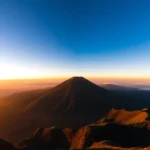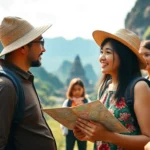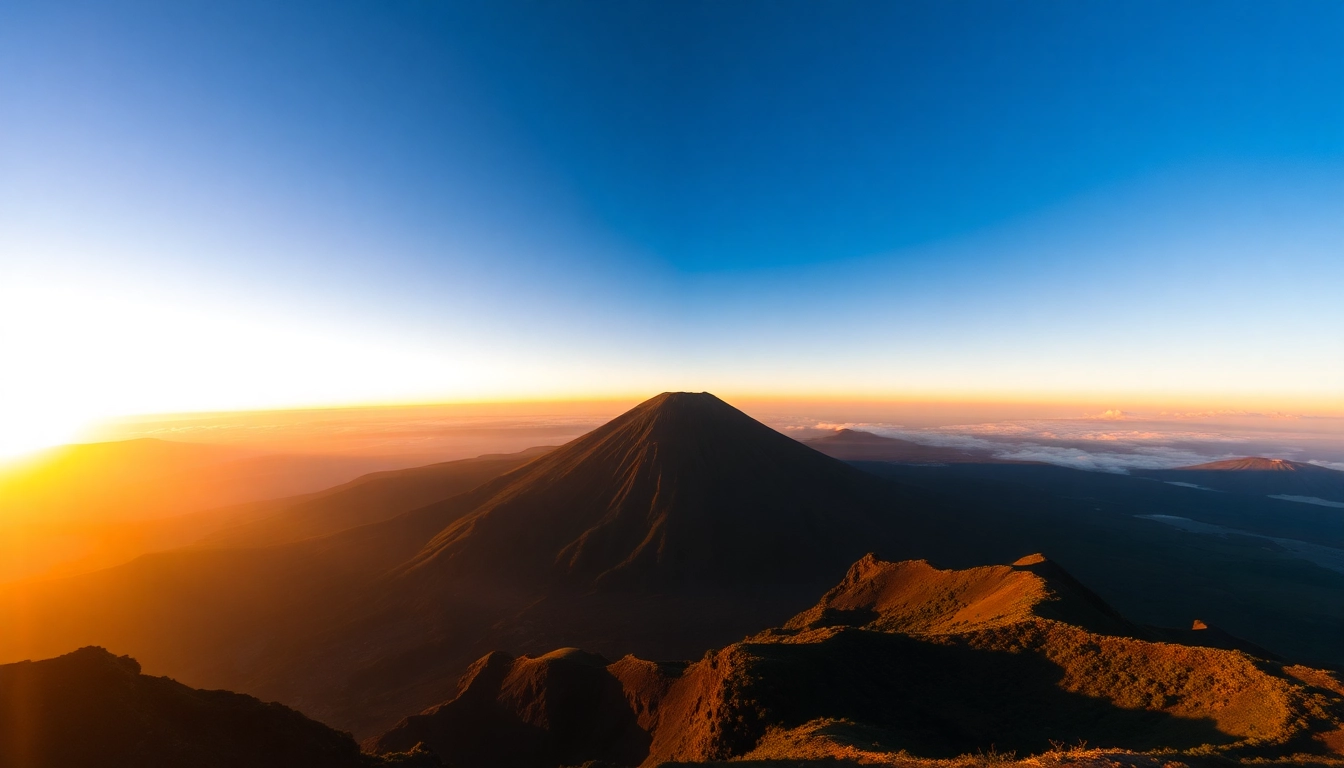Introduction to Mount Rinjani and Its Significance
Nestled in the heart of Lombok, Indonesia, Mt. Rinjani stands as a majestic and active stratovolcano that commands awe and admiration from travelers, environmentalists, and cultural enthusiasts alike. With a summit reaching an imposing 3,726 meters above sea level, it holds the distinction as the second-highest volcano in Indonesia, only surpassed by the towering Mount Kerinci. Its towering presence is not just a geographic marvel but also a vital part of Indonesia’s geological, ecological, and cultural landscape.
As an active volcano, Rinjani’s history is marked by periods of significant eruptions and activity that have shaped both the physical terrain and local communities. Its unique geological features are complemented by the lush biodiversity that surrounds it, making it a focal point for scientific exploration and eco-tourism. Furthermore, Rinjani is deeply embedded in local folklore and spiritual practices, contributing to its cultural importance.
Geographical Location and Key Facts
Located on the island of Lombok in West Nusa Tenggara, Indonesia, Mount Rinjani dominates the northern part of the island with its impressive height and imposing silhouette. The mountain is situated within the boundaries of the Gunung Rinjani National Park, a protected area recognized for its rich biodiversity and geological significance.
The volcano’s summit, known as the “Peak of Rinjani,” reaches 3,726 meters (12,259 feet), making it the second tallest volcanic mountain in Indonesia. Its elevation creates a distinct climatic zone that ranges from tropical rainforest at its base to alpine conditions near the summit. Each year, thousands of trekkers and adventure seekers attempt to conquer Rinjani, drawn by its scenic vistas, challenging trek routes, and the allure of standing atop one of Southeast Asia’s most iconic volcanoes.
The volcano’s caldera, called Segara Anak (“Child of the Sea”), is a breathtaking crater lake with striking turquoise waters that lie within the volcanic crater. This lake is a prominent feature and a highlight for many visitors, offering opportunities for camping, hot springs, and spiritual reflection.
Cultural and Historical Importance
Mount Rinjani holds deep cultural significance for the Sasak and Lombok local communities, who have long regarded it as a sacred site. Mythologies and folklore woven through generations describe Rinjani as a divine threshold, representing both creation and destruction, reflecting Indonesia’s broader volcanic heritage.
Historically, Rinjani’s eruptions have led to significant impacts on local settlements and agriculture. Despite its active status, the mountain remains central to spiritual rituals, with ceremonies conducted by local elders and spiritual leaders aimed at honoring the mountain and seeking protection from eruptions.
Archaeological finds and inscriptions in the region suggest that Rinjani has been a site of pilgrimage and reverence for centuries, blending natural awe with spiritual devotion. Today, the mountain continues to symbolize resilience, spiritual connection, and the dynamic relationship between humans and nature.
Why Mount Rinjani Is a Must-Visit Destination
For adventurers, nature lovers, and cultural enthusiasts, Mt. Rinjani offers an unparalleled combination of scenic beauty, challenging trekking routes, and cultural richness. The mountain’s diverse ecosystems and panoramic vistas are truly captivating, providing experiences that are both adventurous and spiritually enriching.
The thrill of summiting a towering active volcano, witnessing the sunrise over the caldera, and exploring the surrounding national park with its rich flora and fauna make Rinjani a top destination in Indonesia. Moreover, the mountain’s accessibility and the relative safety of organized treks make it an attractive choice for both seasoned climbers and first-time adventurers.
Beyond its physical allure, Rinjani’s cultural heritage, including local ceremonies and traditional stories, adds depth to the experience, fostering a sense of connection to the land and its people. The area also offers opportunities to explore nearby waterfalls, hot springs, and indigenous villages, making it a comprehensive and memorable journey.
Climbing Mount Rinjani: Trekking Routes and Preparations
Popular Trekking Routes (Sembalun and Senaru)
Mount Rinjani features two main trekking routes favored by adventurers: the Sembalun route and the Senaru route. Each offers unique landscapes, challenges, and cultural experiences.
Sembalun Route
Starting from the Sembalun Valley, this route is renowned for its gradual ascent through grassy fields, savannahs, and rolling hills. It is considered slightly easier and more accessible for most trekkers, offering stunning views of the surrounding mountains and the caldera. The trek typically takes 3 to 4 days, culminating in the summit at sunrise.
Senaru Route
Commencing from the village of Senaru, this route is often regarded as more adventurous and challenging due to its steeper terrain and forested paths. It provides a lush journey through tropical rainforest, waterfalls, and botanical diversity. Trekkers usually spend 3 to 4 days on this route, with opportunities for exploring the Rinjani Waterfalls along the way.
Essential Equipment and Safety Tips
Preparing adequately for the Rinjani trek is crucial for safety and enjoyment. Essential gear includes sturdy hiking boots, warm layered clothing, rain protection, a good quality sleeping bag, headlamps, trekking poles, and sufficient water and high-energy snacks.
Safety tips encompass acclimatization strategies, respecting the environment, and being aware of the signs of altitude sickness. It is highly recommended to trek with experienced guides, especially considering the volatile nature of an active volcano.
Guides, Permits, and Best Seasons for Trekking
Guided treks are strongly recommended, with local guides offering expertise on terrain, safety, and cultural insights. Guides and porters typically charge between Rp. 350,000 to Rp. 1,400,000 for a 4-day trek, depending on services included. Permits are required for trekking, which can be arranged via official agencies or tour operators.
The optimal trekking seasons are during the dry months—from May to September—when weather conditions are most stable. Avoid the rainy season (November to April), as trails become hazardous due to mudslides and slippery paths.
Nature and Wildlife Around Mount Rinjani
Unique Flora and Fauna of Rinjani National Park
Rinjani National Park is a haven for biodiversity, hosting a wide array of plant and animal species. The park’s flora includes endemic orchids, towering bamboo forests, and rare medicinal plants, many of which are still being studied for their ecological and pharmaceutical values.
Wildlife includes several endangered species such as the Javan rhino, leopard cat, and the Flores hawk-eagle. The lush forests provide habitat for a multitude of insects, birds, and small mammals, making it a prime location for eco-tourism and scientific research.
Waterfalls and Hot Springs to Discover
The environs of Rinjani boast spectacular waterfalls like Sendang Gila and Tiu Kelep, which cascade down lush jungle slopes—perfect for relaxing after a trek or for sightseeing. Additionally, the hot springs near Segara Anak provide natural therapeutic baths, which are considered both rejuvenating and spiritually significant.
Conservation Efforts and Responsible Tourism
Recognizing the ecological significance of Rinjani, conservation initiatives focus on habitat preservation, anti-poaching measures, and community engagement. Visitors are encouraged to practice responsible tourism by minimizing waste, adhering to designated trails, and supporting local communities through eco-friendly activities.
Planning Your Mount Rinjani Adventure
Budgeting and Cost of Trekking Guides
A typical four-day trek, including guides, permits, and basic equipment, can cost approximately Rp. 1,200,000 to Rp. 1,400,000 per person for guides and porters. Other expenses including travel, accommodation, and meals vary depending on preferences and arrangements. Budgeting ahead ensures smooth logistics and safety.
Travel Tips for Lombok and Nearby Attractions
Lombok offers a variety of attractions beyond Rinjani, including pristine beaches like Senggigi, traditional villages such as Sade, and scenic islands like Gili Air. For an optimal experience, plan your trip to combine trekking with cultural immersion and relaxation. Local transportation options such as motorbike rentals, private drivers, and guided tours will facilitate exploration.
Local Culture and Community Engagement
Engaging with the local communities enriches your journey—participate in traditional ceremonies, support local artisans, and learn about Lombok’s unique customs and handicrafts. Responsible tourism not only benefits local livelihoods but also fosters preservation of cultural heritage.
Recent Eruptions and Safety Records of Mount Rinjani
History of Volcanic Activity
Mount Rinjani’s eruptions have historically ranged from small ash emissions to significant explosive events. Notable eruptions occurred in recent decades, including activity in 2015 which included ash plumes rising up to 6 km. Its activity is closely monitored by Indonesian volcanological agencies to assess risks.
Monitoring and Emergency Preparedness
Rinjani is under constant surveillance using seismic sensors, satellite imagery, and atmospheric measurements. Emergency response plans are in place for guiding authorities and local communities, including evacuation routes and safety protocols for trekkers. Visitors are advised to stay updated on eruption alerts and heed guidance from authorities.
Myths and Facts About Rinjani’s Eruptions
Myths surrounding Rinjani often depict it as a divine entity capable of destructive wrath, but scientific data provides a clearer understanding of its activity cycles. While eruptions pose risks, modern monitoring and preparedness significantly mitigate potential hazards, allowing safe appreciation of its natural beauty.





